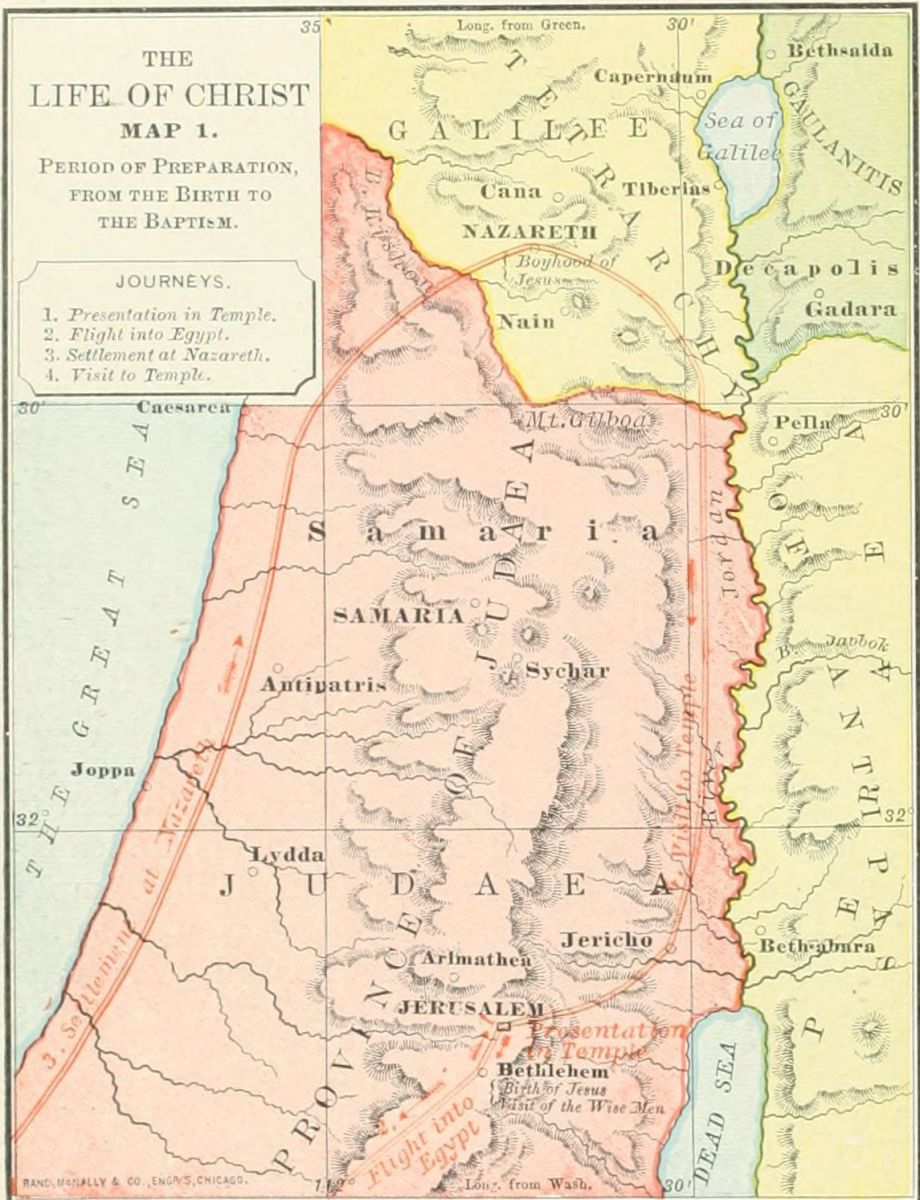
As the life of Jesus Christ on earth is the most important not only in all Bible history, but in all human history as well, it is desirable that the Bible student, and especially the Bible teacher, should obtain a clear understanding of its leading events, associate them with the places where they occurred, and arrange them in chronological order. Of the 150 principal events, about 100 are fixed as to their chronological order by the common consent of the leading harmonists; about 25 are agreed upon by the majority; while the remaining 25 are altogether uncertain. In the outline here given, the authorities most relied upon are Andrews, Robinson, Geikie, and Strong, yet no one of them is exclusively followed. We divide the earthly life of Jesus into nine periods, to each of which is given a separate map, so that the student may not be confused among the various lines of the Saviour's journeying.
The periods are as follows:
I. Period of Preparation, 30 years, from the Birth to the Baptism of Jesus.
II. Period of Inauguration, 15 months, from the Baptism to the Rejection at Nazareth.
III. Period of Early Galilean Ministry, 4 months, from the Rejection at Nazareth to the Sermon on the Mount.
IV. Period of Later Galilean Ministry, 10 months, from the Sermon on the Mount to the Feeding of the Five Thousand.
V. Period of Retirement, 6 months, from the Feeding of the Five Thousand to the Feast of Tabernacles.
VI. Period of Judæan Ministry, 3 months, from the Feast of Tabernacles to the Feast of Dedication.
VII. Period of Peræan Ministry, 4 months, from the Feast of Dedication to the Anointing at Bethany.
VIII. Period of the Passion, 8 days, from the Anointing at Bethany to the Resurrection.
IX. Period of the Resurrection, 40 days, from the Resurrection to the Ascension.
This includes the events of 30 years, from the Birth of Jesus to his Baptism, and though the longest, contains the fewest recorded incidents of any. Upon the map are indicated by red lines four journeys of Jesus.
1. The Presentation in the Temple. (From Bethlehem to Jerusalem and return.) From Bethlehem, his birthplace, the infant Jesus, at the age of 40 days, was taken to Jerusalem, to be presented before the Lord in the Temple. Here he was recognized as the Messiah of Israel, by Simeon and Anna, and then was taken back to Bethlehem. (Luke 2:22-38.)
2. The Flight into Egypt. (From Bethlehem to Egypt.) After the visit of the Wise Men, the Saviour, still an infant, was taken down to Egypt, in order to escape the jealousy of Herod the Great. (Matt. 2:1-18.)
3. The Settlement at Nazareth. (From Egypt to Nazareth.) After the death of Herod, Jesus was taken from Egypt to Galilee, to the village of Nazareth, the early home of Joseph and Mary. Here he spent his youth. (Matt. 2:19-23.)
4. The Visit to the Temple. (From Nazareth to Jerusalem and return.) The only recorded event of the Saviour's youth, is his journey to Jerusalem, at the age of 12 years, to attend the Passover. On the return journey, he was lost by his parents, and after three days, found in the Temple (probably in the Court of the Women), conversing with the doctors of the law. He returned with Joseph and Mary to Nazareth (Luke 2:40-52), and thenceforth no events in his life for 18 years are related.
The places in this period are: (1.) Bethlehem, a village six miles southwest of Jerusalem, now Beit-lahm. (2.) The Temple in Jerusalem. (3.) Nazareth, a village on the border of the Plain of Esdraelon, in Galilee, now en Nasireh, a place of 6,000 population.

1. Presentation in the Temple. (Bethlehem to Jerusalem and return.) Recognized by Simeon and Anna.
2. Flight into Egypt. (Bethlehem to Egypt.) Escape from Herod.
3. Settlement at Nazareth. (Egypt to Nazareth.) Childhood and youth.
4. Visit to the Temple. (Nazareth to Jerusalem and return.) Found among the doctors.
This embraces 15 months, from the Baptism of Jesus to the Rejection at Nazareth, and contains the record of five journeys. Its places are as follows: 1. Nazareth, already located. 2. Bethabara was formerly supposed to be the ancient Beth-Nimrah, now Nimrin, on a small stream east of the Jordan, not far from the Dead Sea. But Conder locates it at Abarah, a ford of the Jordan above Beth-shean, and near the Sea of Galilee. 3. "The Wilderness" is probably the uninhabited region of Judæa near the Dead Sea, though it may have been the desert far to the south. 4. Cana is located at Kefr Kenna, northeast of Nazareth, though Dr. Robinson places it at Kana el Jelil, 9 miles north of Nazareth. 5. Capernaum was probably at Khan Minyeh, on the west of the Sea of Galilee, though long located at Tell Hum, on the north. 6. Jerusalem. 7. Sychar, the ancient Shechem, now Nablus, beside Mount Gerizim. The journeys of this period are named, each from its leading event.
1. The Baptism. (From Nazareth to Bethabara.) Near the close of John the Baptist's ministry, Jesus left his carpenter shop at Nazareth, and journeyed down the Jordan Valley to Bethabara. There he was baptized by John, and received from heaven the testimony of his sonship. (Matt. 3:13-17.)
2. The Temptation. (From Bethabara to the Wilderness and return.) (1.) Immediately after his baptism, Jesus was led by the Spirit into the Wilderness, where he fasted 40 days, and overcame the temptations of Satan. (Matt. 4:1-11.) (2.) Returning to Bethabara, he received the testimony of John the Baptist, and met his earliest followers, Andrew and Peter, John, Philip, and Nathanael. (John 1:37-50.)
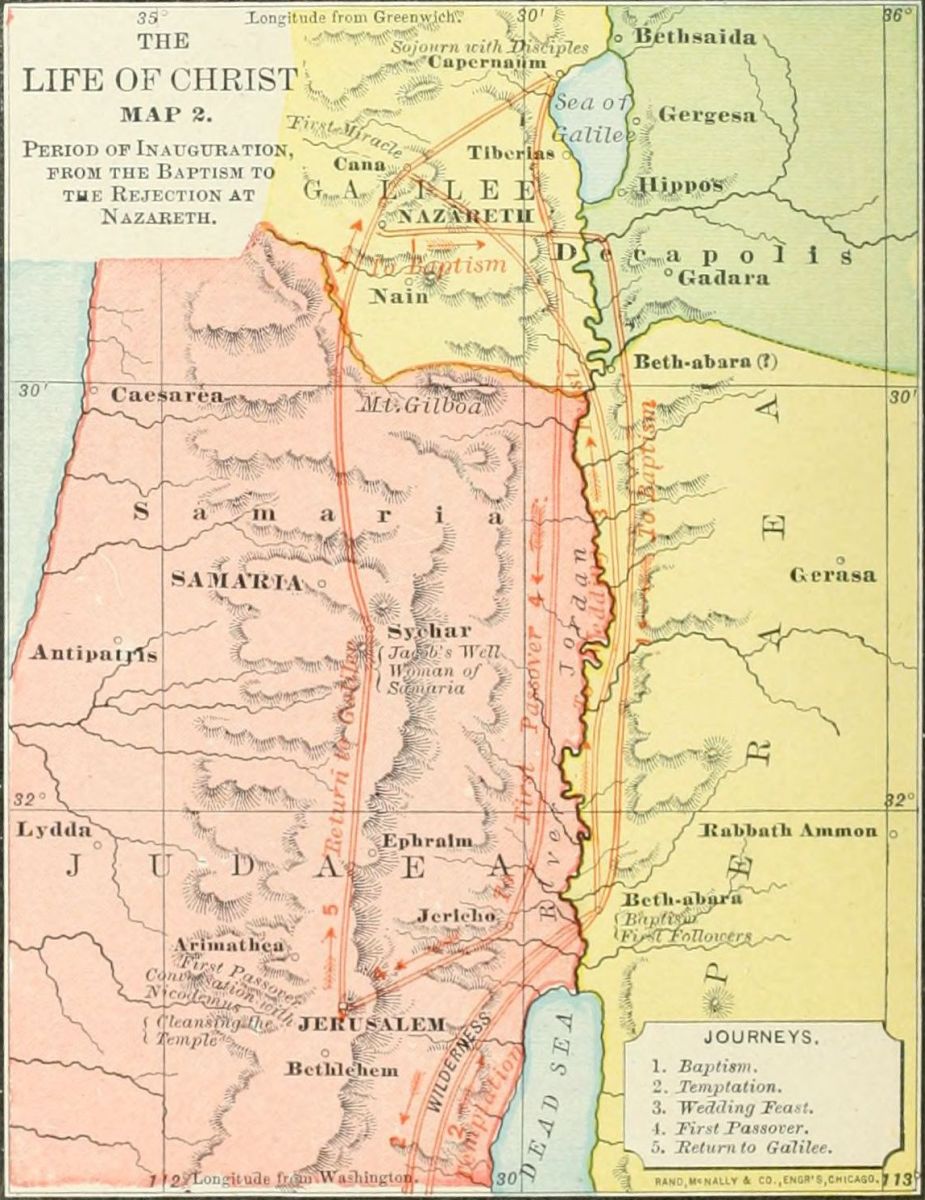
3. The Marriage at Cana. (Bethabara to Cana and Capernaum.) (1.) Jesus left Bethabara, journeyed up the Jordan Valley to Galilee, and over the mountains to Cana, near Nazareth. Here he was present at a wedding, and wrought his first miracle, turning the water into wine. (2.) Thence, with his mother and brothers, he went down to Capernaum, by the Sea of Galilee, and remained a few days. (John 2:1-12.)
4. The First Passover. (Capernaum to Jerusalem.) (1.) Soon after the wedding feast Jesus went up to Jerusalem, probably by way of the Jordan Valley, to attend the first Passover of his ministry. (John 2:13.) (2.) At Jerusalem he asserted his authority by cleansing the Temple from the traders. (John 2:14-22.) (3.) He held the conversation with Nicodemus concerning the new birth, and remained for a time in Judæa, gathering a few disciples, yet not making his ministry prominent, while his forerunner was still preaching. (John 3:1-36.)
5. The Return to Galilee. (Jerusalem to Sychar and Cana.) (1.) As soon as the teaching of John the Baptist was ended by his imprisonment, Jesus left Judæa to open his own public ministry. (2.) He went through Samaria, and paused at Jacob's well for the conversation with the Samaritan woman, and then remained at Sychar, the ancient Shechem, two days. (3.) At Cana, the place of his earlier miracle, he spoke the word of healing for a nobleman's son, who was sick at Capernaum. (John 4:1-54.)
1. Baptism. (Nazareth to Bethabara.)
2. Temptation. (Bethabara to Wilderness and return.) (1.) The temptation. (2.) The first followers.
3. Marriage at Cana. (Bethabara to Cana and Capernaum.) (1.) The first miracle. (2.) The visit to Capernaum.
4. First Passover. (Capernaum to Jerusalem.) (1.) The Passover. (2.) Cleansing the Temple. (3.) Discourse with Nicodemus.
5. Return to Galilee. (Jerusalem to Sychar and Cana.) (1.) The departure. (2.) The woman of Samaria. (3.) The nobleman's son.
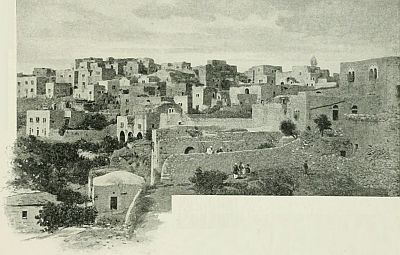 BETHLEHEM.
BETHLEHEM.
This is a period of about four months, from the Rejection at Nazareth to the Sermon on the Mount. It brings to notice six places, most of which have been already noticed. 1. Cana. 2. Nazareth. 3. Capernaum. 4. Eastern Galilee, the region on the shore of the Sea of Galilee. 5. Jerusalem. 6. The mountain of the sermon. This was probably Kurûn Hattin, "the horns of Hattin," a mountain with a double peak, a few miles from the Sea of Galilee. The journeys of this period are four in number.
1. The Opening of the Ministry. (From Cana to Nazareth and Capernaum.) (1.) He came (perhaps from Cana) to Nazareth, with the intention of commencing his ministry in his own home. But his towns-people rejected his message, and would have slain him if he had not escaped from their hands. (Luke 4:16-31.) (2.) Rejected in his own city, he removed to Capernaum, which thenceforward was the centre of his ministry for more than a year. (Luke 4:31.) (3.) Here he called from their work at the seaside his four earliest disciples, Simon and Andrew, James and John. They had known him before, but now left all to follow him. (Luke 5:1-11.) (4.) In the synagogue, on the sabbath, he cast out an evil spirit (Luke 4:33-36), and healed the mother of Peter's wife. (Luke 4:38-40.)
2. The Tour in Eastern Galilee. (From Capernaum through Eastern Galilee and return.) (1.) This journey was probably near the Sea of Galilee, and may not have occupied more than a few weeks. (2.) During its progress he healed a leper, whose testimony led such multitudes to come seeking miracles that Jesus was compelled to go into retirement. (3.) On his return to Capernaum he healed a paralytic let down through the roof, and (4.) called the publican Matthew to be one of his disciples. (Luke 5:17-28.)
3. The Second Passover. (From Capernaum to Jerusalem and return.) (1.) In the spring of the second year of his ministry he went up to the feast at the capital, and while there healed a cripple at the Pool of Bethesda. (John 5:1-47.) (2.) On his return, while walking through the wheat fields, he asserted his authority as "Lord of the sabbath." (Luke 6:1-5.) (3.) On a sabbath soon after, he healed in the synagogue a man with a withered hand. (Luke 6:6-11.)
4. The Sermon on the Mount. (From Capernaum to the mountain.) (1.) The opposition of the Pharisees caused Jesus to leave Capernaum and instruct the people by the sea-shore. (Mark 3:7-12.) (2.) He ascended a mountain, probably Kurûn Hattin, and, after a night in prayer, appointed the Twelve Apostles. (Luke 6:12-16.) (3.) To the disciples and the multitude he preached the Sermon on the Mount. (Matt. 5-7.)
1. Opening of the Ministry. (Cana to Nazareth and Capernaum.) (1.) Rejection at Nazareth. (2.) Settlement at Capernaum. (3.) Calling of Simon and Andrew, James and John. (4.) Demoniac healed, and Peter's wife's mother healed.
2. Tour in Eastern Galilee. (Capernaum to Eastern Galilee and return.) (1.) Preaching in Galilee. (2.) Leper healed. (3.) Paralytic healed. (4.) Matthew called.
3. Second Passover. (Capernaum to Jerusalem and return.) (1.) The cripple at Bethesda. (2.) Through the wheat fields. (3.) Withered hand healed.
4. Sermon on the Mount. (Capernaum to the mountain.) (1.) By the sea. (2.) Calling the Twelve. (3.) The sermon.
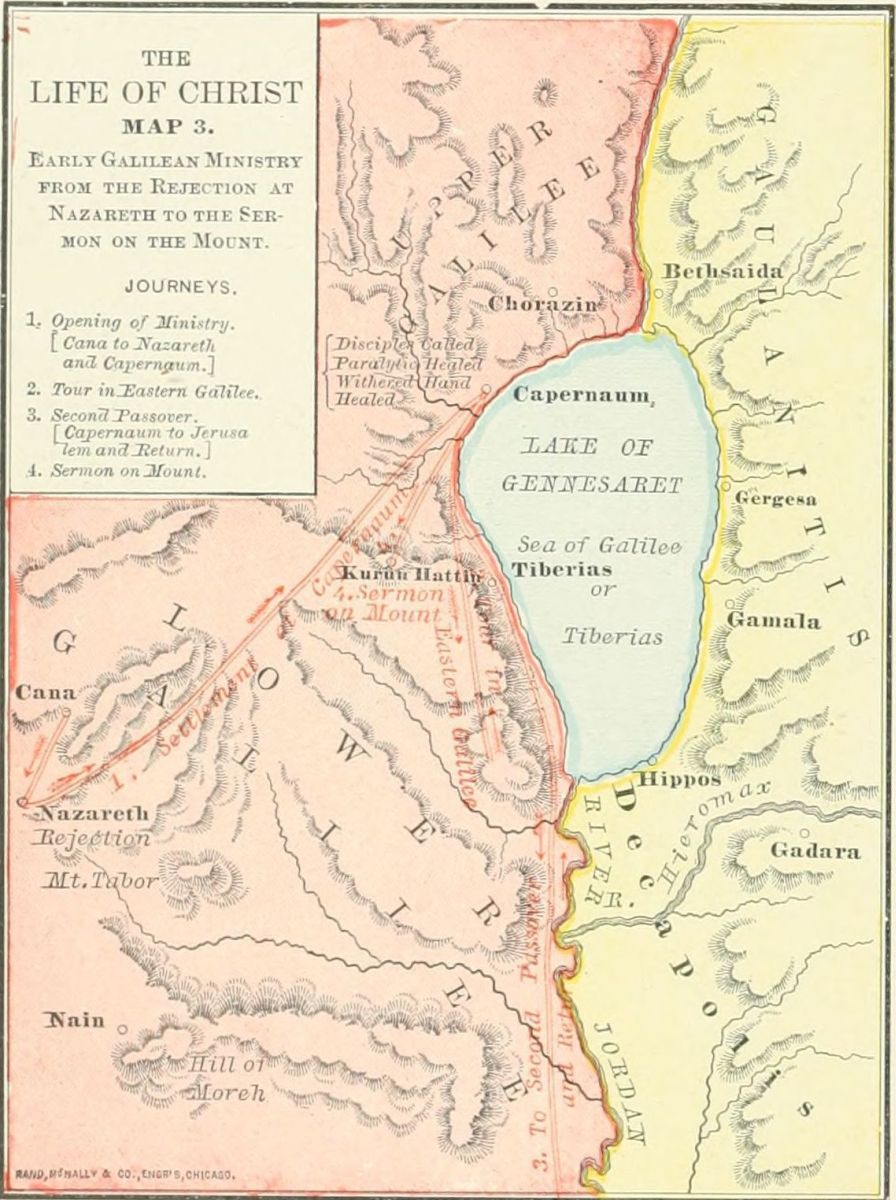
This period of ten months, from the Sermon on the Mount to the Feeding of the Five Thousand, was a time of opposition on the part of the ruling classes, but continued popularity among the people. The places which Jesus visited at this time were: 1. Capernaum, already noticed, and still the headquarters of his ministry. 2. Nain, now called Nein, on the northwestern edge of Little Hermon, six miles southeast of Nazareth, in full view of Mount Tabor. 3. "The country of the Gadarenes" (Mark 5:1); called by Matthew (8:28) "the country of the Gergesenes." Gadara was the largest city of the region, situated south of the Sea of Galilee, and giving its name to the district; Gergesa, the little village east of the Sea of Galilee, now called Khersa. 4. Nazareth, already noticed under Period I. 5. Bethsaida, a city at the head of the Sea of Galilee, supposed by some to have been on both sides of the Jordan, by others on the east side. 6. The plain of Gennesaret, near to Capernaum. We arrange the events of this period under four journeys.
1. The Tour in Southern Galilee. (From Capernaum to Nain and return.) The following events belong to this tour: (1.) At Capernaum, before starting, Jesus healed the slave of a believing centurion. (Luke 7:1-10.) (2.) On the next day he led his disciples southward to Nain, where he raised to life the widow's son, about to be buried. (Luke 7:11-17.) (3.) Perhaps at the same time and place he received the messengers and answered the questions of John the Baptist. (Luke 7:18-35.) (4.) During the journey he was entertained by a Pharisee, at whose house "a woman who was a sinner" washed his feet. (Luke 7:36-50.) (5.) On his return the healing of a dumb demoniac occasioned the Pharisees to assume an open opposition, and to declare that his miracles were wrought by the power of the evil spirit. (Luke 11:14-26.) (6.) At the same time occurred the interference of his mother and brethren, desiring to restrain him. (Luke 8:19-21.)
2. The Gadarene Voyage. (Capernaum to Gergesa and return.) With this journey are associated four events. (1.) The opposition of the enemies caused Jesus to leave the city, and to teach in parables by the sea. (Matt. 13:1-53.) (2.) From the shore, near Capernaum, he set sail for the country of the Gadarenes, east of the Sea of Galilee, and on the voyage stilled a sudden tempest. (Mark 4:35-41.) (3.) At the eastern shore, near the village of Gergesa, he restored two demoniacs, permitted the demons to enter a herd of swine, and as a result was besought by the people to leave their coasts. (4.) Returning across the sea to Capernaum, he raised to life the daughter of Jairus the ruler. (Luke 8:41-56.)
3. The Tour in Central Galilee. (From Capernaum to Nazareth and return.) (1.) Starting from Capernaum with his disciples, he visited Nazareth a second time, but was again rejected by its people. (Mark 6:1-6.) (2.) He then gave the Twelve a charge, and sent them out to preach. (Matt. 10:5-42.) (3.) While they were absent upon their mission, Jesus himself also journeyed preaching through Central Galilee. (Mark 6:6.) This was his third tour in Galilee. (4.) On his return to Capernaum, he received the report of the Twelve, and the news of John the Baptist's murder by Herod Antipas. (Mark 6:14-30.)
4. The Retirement to Bethsaida. (1.) The multitudes following him led Jesus to leave Capernaum by sea for a retired place near Bethsaida. (Mark 6:31, 32.) (2.) The people hastened after Jesus, and met him as he landed, so that he was compelled to teach them all day, and wrought in the afternoon the miracle of the Five Loaves. (Mark 6:32-44.) (3.) After the miracle he sent the disciples out upon the sea, and at midnight walked to them upon the water. (Mark 6:45-51.) (4.) In the morning they landed at the plain of Gennesaret, near Capernaum, where Jesus wrought many miracles (Mark 6:52-56), and then returned to Capernaum. (5.) Here he completed his Galilean ministry by a discourse in the synagogue on the "Bread of Life." (John 6:25-59.)
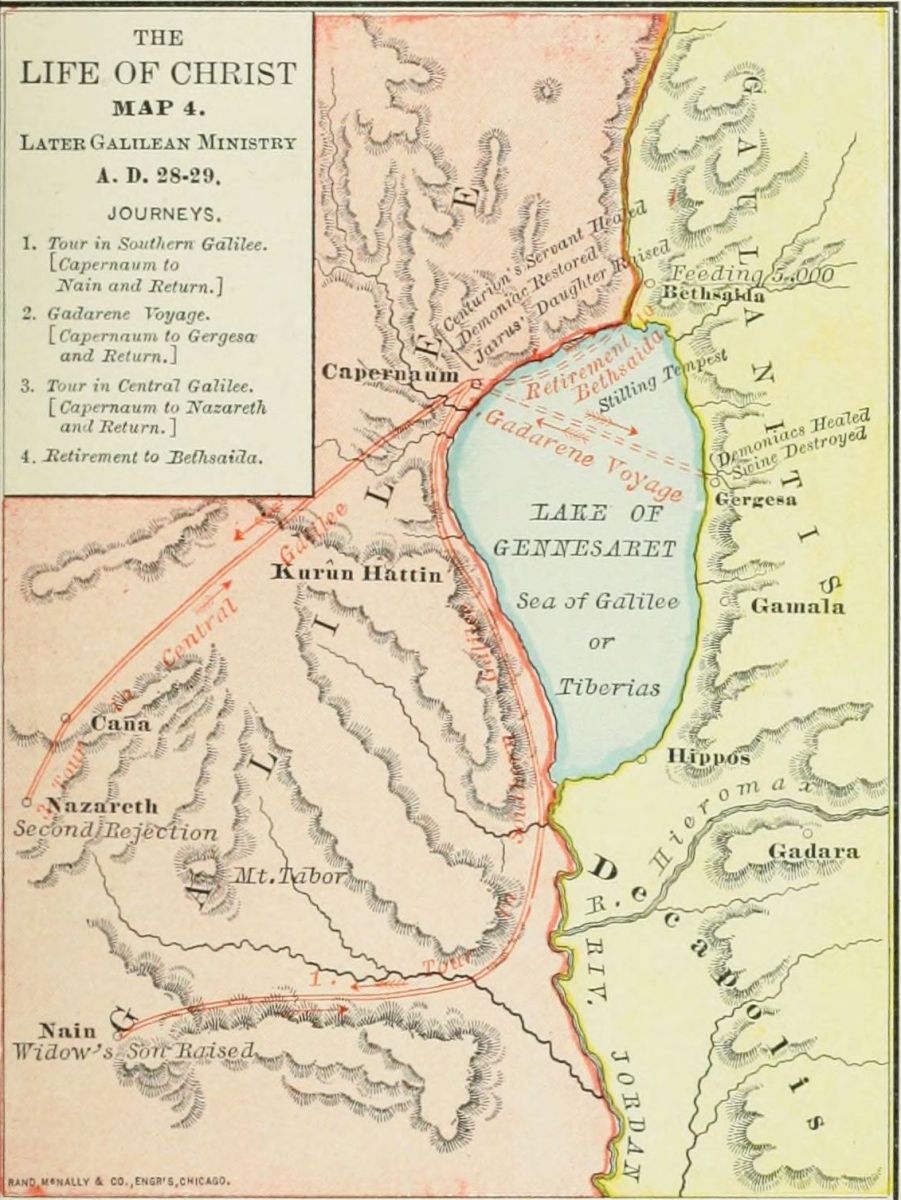
1. Tour in Southern Galilee. (Capernaum to Nain and return.) (1.) Centurion's servant healed. (2.) Widow's son at Nain raised. (3.) Messengers from John. (4.) Washing the Saviour's feet. (5.) Dumb demoniac, and opposition of Pharisees. (6.) Interference of relatives.
2. Gadarene Voyage. (Capernaum to Gergesa and return.) (1.) Parables by the sea. (2.) Stilling the tempest. (3.) Gadarene demoniacs. (4.) Jairus' daughter raised.
3. Tour in Central Galilee. (Capernaum to Nazareth and return.) (1.) Second rejection at Nazareth. (2.) Mission of the Twelve. (3.) Third tour in Galilee. (4.) Report of the Twelve, and death of John the Baptist.
4. Retirement to Bethsaida. (Capernaum to Bethsaida and return.) (1.) Seeking retirement. (2.) Feeding the five thousand. (3.) Walking on the sea. (4.) Miracles at Gennesaret. (5.) Discourse on the "Bread of Life."
During most of the six months, from the Feeding of the Five Thousand to the Feast of Tabernacles, in the fall before Christ's crucifixion, he remained in retirement, engaged in instructing his disciples in the deeper truths of the gospel. The places visited at this time were: 1. Phœnicia, "the coasts of Tyre and Sidon," probably only the borders near Galilee, not the cities themselves. 2. Decapolis, the region of the "ten cities," southeast of the Sea of Galilee; a country mainly inhabited by a heathen population. 3. Dalmanutha, a village on the western shore of the Sea of Galilee, not certainly identified, but perhaps at Ain el Barideh, two miles from Tiberias. 4. Bethsaida, already noticed under Period IV. 5. Cæsarea Philippi, at the foot of Mount Hermon, now Banias. 6. Capernaum, already noticed under Period II.
1. The Journey to Phœnicia. (From Capernaum to the borders of Tyre and Sidon.) (1.) The discourse in the synagogue, showing the spiritual nature of Christ's kingdom, led to the defection of the multitude, and the retirement of Jesus and the Twelve. (John 6:60-71.) (2.) At the "coasts," or frontiers, of Tyre and Sidon, he restored the demoniac daughter of a Syrophœnician woman. (Mark 7:24-30.)
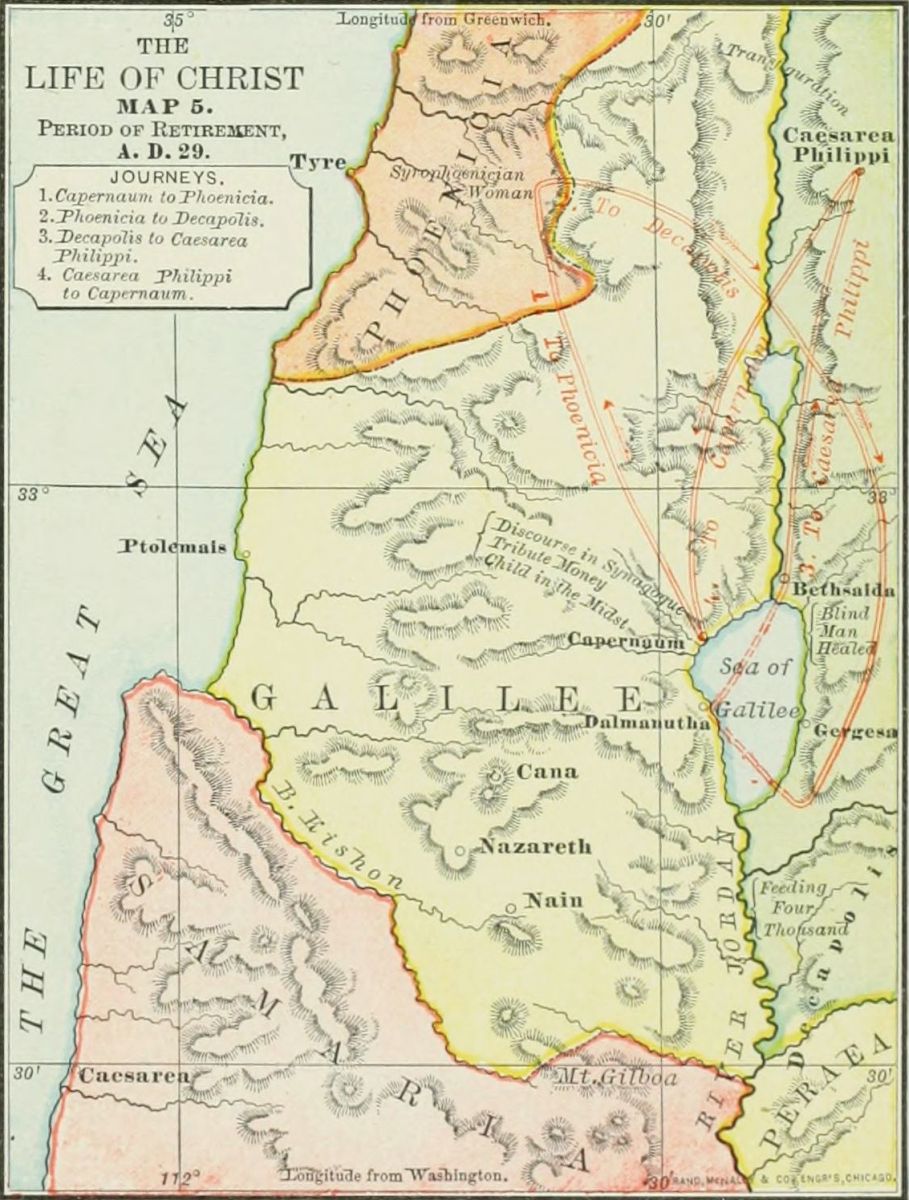
2. The Journey to Decapolis. (From the borders of Tyre and Sidon to Decapolis.) (1.) The crowds gathering around Jesus in Phœnicia, he crossed Galilee, and sought seclusion in Decapolis, southeast of the Sea of Galilee. (Mark 7:31.) (2.) Here he wrought two miracles, healing a deaf stammerer, and feeding the four thousand. (Mark 7:31-37; 8:1-9.)
3. The Journey to Cæsarea Philippi. (From Decapolis to Dalmanutha, Bethsaida and Cæsarea Philippi.) (1.) He sailed across the lake to Dalmanutha, but was met by the Pharisees with unbelieving demands for a sign, so took ship again. (Mark 8:10-13.) (2.) He sailed northward to Bethsaida, where he healed a blind man, who saw "men as trees walking." (Mark 8:22-26.) (3.) Pursuing his way up the Jordan, he came to Cæsarea Philippi, at the foot of Mount Hermon, where he remained several days. (4.) Here occurred Peter's confession, "Thou art the Christ," the transfiguration, and the restoration of the demoniac boy. (Luke 9:18-45.)
4. The Last Return to Capernaum. (From Cæsarea Philippi to Capernaum.) He probably went down the Jordan to Bethsaida, and thence by the shore of the sea to Capernaum. Here he kept in seclusion, and gave his disciples a lesson in humility, from "the child in the midst." (Mark 9:30-50.)
1. To Phœnicia. (Capernaum to coasts of Tyre and Sidon.) (1.) Defection of the multitude. (2.) Syrophœnician woman.
2. To Decapolis. (Phœnicia to Decapolis.) (1.) Journey to Decapolis. (2.) Healing the stammerer, and feeding the four thousand.
3. To Cæsarea Philippi. (Decapolis to Dalmanutha, Bethsaida and Cæsarea Philippi.) (1.) Dalmanutha: a sign demanded. (2.) Bethsaida: blind man healed. (3.) Cæsarea Philippi. (4.) Transfiguration.
4. To Capernaum. (Cæsarea Philippi to Capernaum.) The child in the midst.
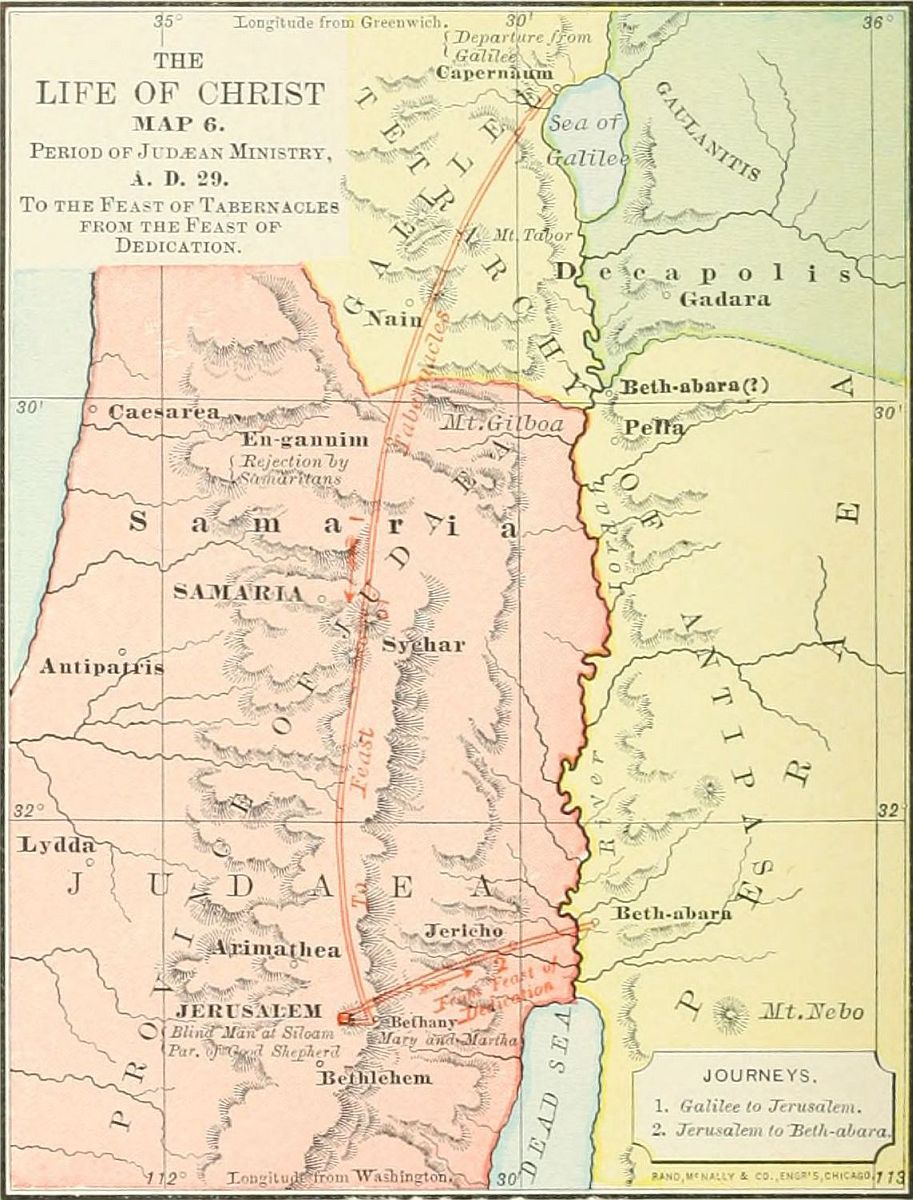
This includes the events of about three months, from the Feast of Tabernacles to the Feast of Dedication. The following places are referred to during this period: 1. Capernaum, noticed under Period II. 2. The "village of the Samaritans" where Jesus was inhospitably treated, has been traditionally located at En-gannim, on the border of Galilee and Samaria. 3. Bethany, a small village on the Mount of Olives, east of Jerusalem, the home of Mary and Martha, now el Nasiriyeh. 4. Jerusalem. 5. Bethabara, on the east of Jordan, referred to as the place of the baptism, in Period II.
This period embraces but two journeys, at its beginning and ending; the one before the Feast of Tabernacles, the other after the Feast of Dedication.
1. From Galilee to Jerusalem. (1.) Bidding farewell to Galilee, Jesus left Capernaum for the last time, and journeyed through Galilee toward Jerusalem. While starting he conversed with "the three aspirants" (Luke 9:57-62), and showed the duty of full devotion to his work. (2.) On the border of Samaria, perhaps at the village of En-gannim, he was rejected by the Samaritans, but refused to allow his disciples to call down fire from heaven, "as Elias did." (Luke 9:52-56.) (3.) While in Samaria he healed the ten lepers, of whom but one turned back to give him thanks. (Luke 17:11-19). (4.) He found a home at Bethany, with Lazarus and his two sisters, and reminded Martha of her needless care, while Mary was seeking "the good part." (Luke 10:38-42.) (5.) He came to Jerusalem during the Feast of Tabernacles, and gave the teachings embodied in John 7-10. (6.) While here he healed the blind man at the Pool of Siloam. (John 9:1-41.)
2. From Jerusalem to Bethabara. (1.) At the Feast of Dedication the teachings of Christ created such an opposition that he left the city. (2.) He went to Bethabara beyond Jordan, the place of the baptism, and there prepared for his tour in Peræa.
1. From Galilee to Jerusalem. (1.) Three aspirants. (2.) Rejected by Samaritans. (3.) Ten lepers. (4.) Mary and Martha. (5.) Feast of Tabernacles. (6.) Blind man at Pool of Siloam.
2. From Jerusalem to Bethabara. (1.) Departure from Jerusalem. (2.) At Bethabara.
This extends through four months, from the events immediately succeeding the Feast of Dedication, to the Anointing at Bethany, six days before the crucifixion. Its places are as follows: 1. Bethabara, already noticed in Period II. 2. Bethany. (See Period VI.) 3. Ephraim. This was probably the village in a wild region northeast of Bethel, in the Old Testament called Ophrah, now et Taiyibeh. 4. Peræa was the province on the east of Jordan, and south of the Hieromax river. It was governed by Herod Antipas, the slayer of John the Baptist, and was inhabited by a mixed population. No towns are named as visited by the Saviour; but we have conjectured a route through most of the province, as shown on the map. 5. Jericho, at that time the largest city in the Jordan Valley, and recently beautified by Herod. It is now a miserable village, called er Riha. This period includes four journeys.
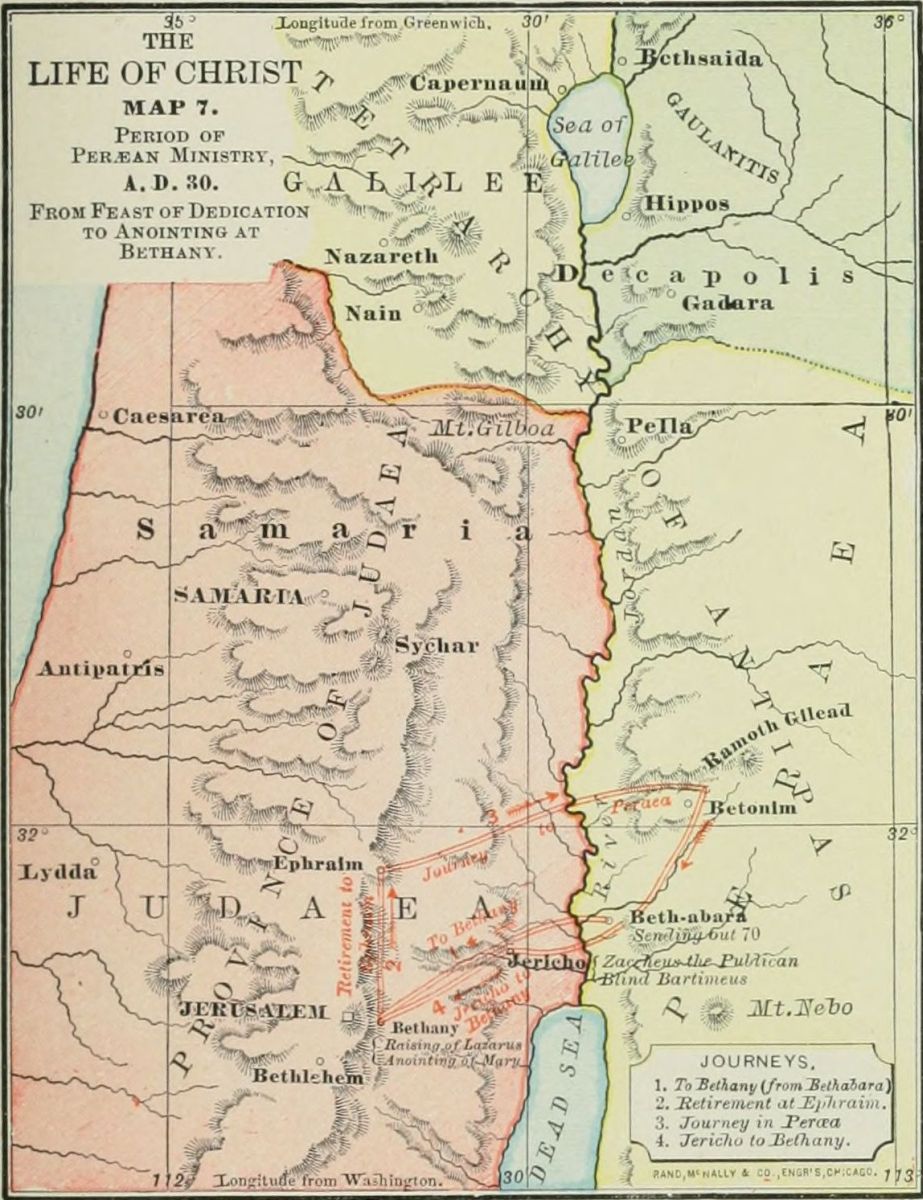
1. From Bethabara to Bethany. (1.) While at Bethabara Jesus sent out the Seventy, to proclaim his coming in the Peræan villages. (Luke 10:1-16.) (2.) Hearing of the sickness of Lazarus, after some delay, he went to Bethany, and raised him from the dead, a miracle which caused the Jewish leaders to formally resolve upon putting Jesus to death. (John 11.)
2. The Retirement to Ephraim. The hour had not yet come for Jesus to die, and he therefore secluded himself from the rulers, in the village of Ephraim, in a wilderness north of Jerusalem, on the mountains overlooking the Jordan Valley. Here he remained several weeks, probably instructing the Twelve.
3. The Journey in Peræa. Descending the mountains, Jesus crossed the Jordan Valley, and entered the province of Peræa. His ministry, during this journey, was of teaching rather than miracle, and is mainly related by Luke. Its events were: (1.) The miracles of healing the woman bent together by an infirmity, and the man with the dropsy. (Luke 13:10-17, and 14:1-6.) (2.) The seven great parables, among them that of the Prodigal Son. (Luke 14-16.) (3.) Blessing the little children. (Luke 18:15-17.) (4.) The rich young ruler's question, and Jesus' answer, "Sell all that thou hast," etc. (Luke 18:18-30.) (5.) The ambitious request of James and John, for the first places in the kingdom of Christ. (Matt. 20:20-28.)
4. From Jericho to Bethany. Jesus had now reached Jericho, on his last journey to Jerusalem, and from this point we notice the following events: (1.) The healing of Bartimeus at the gate of Jericho. (Luke 18:35-43.) (2.) The visit of Jesus at the house of Zaccheus the publican. (Luke 19:1-10.) (3.) At the end of his journey, the anointing by Mary at Bethany, on the Saturday evening before the Passover. (John 12:1-8.)
1. Bethabara to Bethany. (1.) Sending the Seventy. (2.) Raising of Lazarus.
2. Retirement to Ephraim.
3. Journey in Peræa. (1.) Two miracles (infirm woman, and dropsy). (2.) Seven parables. (3.) Blessing little children. (4.) Rich young ruler. (5.) Request of James and John.
4. Jericho to Bethany. (1.) Bartimeus. (2.) Zaccheus. (3.) Anointing by Mary.
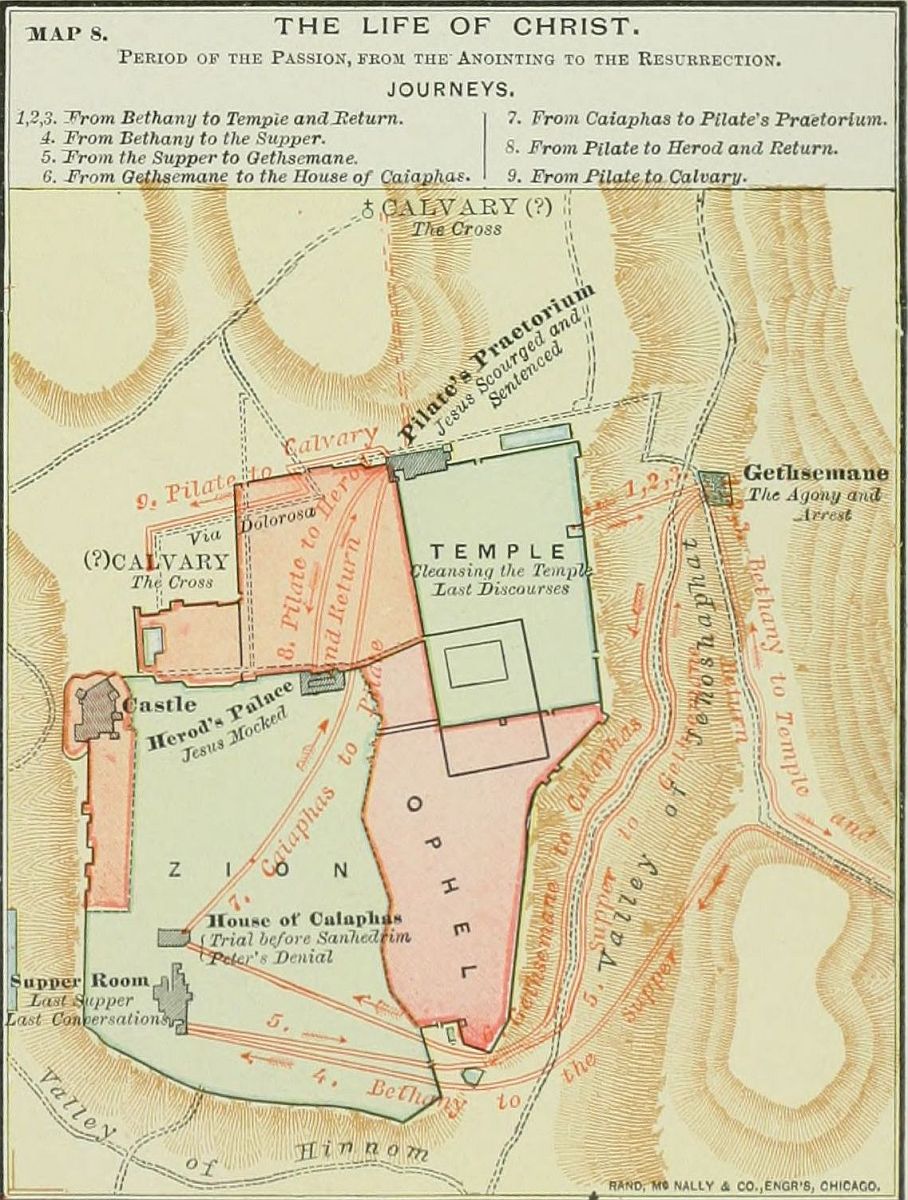
Although this period embraces only the week from the Anointing by Mary to the Death of Jesus on the cross, its events are so minutely related by the Evangelists as to occupy one-third of the Gospels. If the entire life of Jesus were as fully written out, it would fill nearly 80 volumes as large as the Bible. The events of the Passion-Week took place in and near Jerusalem. The locations on the map are those of tradition only, and are largely conjectural, while the lines of the journeyings are entirely unknown. The map is intended merely as a guide to the student in presenting the order of events, and must not be regarded as fixing the places with any authority. We arrange the events under nine short journeys.
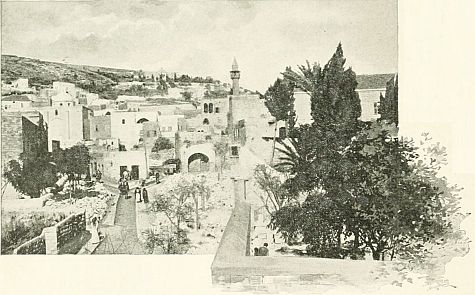 NAZARETH.
NAZARETH.
1, 2, 3. From Bethany to the Temple and Return. These three journeys took place on successive days, and were marked by distinctive events. (1.) The First Journey, on Sunday, was the triumphal entry into the city and the Temple, after which Jesus returned for the night to Bethany. (Matt. 21:1-11.) (2.) The Second Journey, on Monday, was marked by the cleansing of the Temple, when for the second time the Saviour drove out of the Court of the Gentiles those who made it a place of trade. (3.) The Third Journey, on Tuesday, was made memorable by the last teachings of Jesus, to the people and rulers in the Temple, and to the Twelve on the Mount of Olives, looking down upon the city. (Matt. 21-25.) At the close of each of these three days Jesus returned to Bethany, where he remained in seclusion on Wednesday, no event of that day being left on record.
4. From Bethany to the Supper. The traditional place of the Cœnaculum, or supper-room, is on Mount Zion, where Jesus came with his disciples on Thursday evening. Here took place the Last Supper, and the farewell conversation of Jesus with his disciples. (John 13-17.)
5. From the Supper to Gethsemane. Near midnight of Thursday, Jesus and his disciples (Judas being absent) left the supper-room, and walked up the Valley of Jehoshaphat to the Garden of Gethsemane. Here Jesus endured the agony, and here he was arrested by the officers of the Jews, led by Judas. (Matt. 26:36-56.)
6. From Gethsemane to the House of Caiaphas. The fettered Jesus was dragged by the crowd, first to the house of Annas (John 18:13-15), for a brief examination, thence to the house of Caiaphas for the formal trial before the Sanhedrim. This place is traditionally located on Mount Zion, near the house of the Last Supper. Here he was condemned by the rulers, and mocked by their servants. (John 18:16-28.)
7. From Caiaphas to Pilate. Jesus was brought before the Roman procurator at his prætorium, or place of judgment. We are inclined to think that this was the castle built by Herod the Great on Mount Zion; but we give on the map the traditional location at the Tower Antonia, north of the Temple. Here Jesus was examined by Pilate, who vainly sought to deliver him, being convinced of his innocence. (John 18:28-38.)
8. From Pilate to Herod and Return. Wishing to avoid the responsibility of condemning Jesus, Pilate sent him to Herod Antipas, who was then in the city, probably in the palace of the Asmonean (Maccabean) kings. But Herod only mocked Jesus, and returned him to Pilate. (Luke 23:8-12.)
9. From Pilate to Calvary. At last Pilate gave orders for the crucifixion of Jesus. He was now led forth, bearing his cross, perhaps by the street called Via Dolorosa, "the Sorrowful Way," to the place Golgotha, or Calvary, outside the wall, where three crosses were erected, and the Saviour of the world was crucified. As two locations of Calvary are now given, both are indicated, and a journey from Pilate's castle to each. The route to the northern locality is indicated by dotted lines.
1. Bethany to Temple and Return. Triumphal entry.
2. Bethany to Temple and Return. Cleansing the Temple.
3. Bethany to Temple and Return. Last discourses.
4. Bethany to Supper. Last Supper.
5. Supper to Gethsemane. (1.) Agony. (2.) Arrest.
6. Gethsemane to Caiaphas. (1.) To Annas. (2.) To Caiaphas.
7. Caiaphas to Pilate.
8. Pilate to Herod and Return.
9. Pilate to Calvary. (1.) Crucifixion. (2.) Death. (3.) Burial.
The events of the forty days between the Resurrection and the Ascension of Jesus cannot be arranged as journeys, since his resurrection body moved from place to place by the will of his spirit. The student may therefore consult the Map of Palestine during the ministry of Jesus for the places referred to in the account of this period. Of the ten recorded appearances, five were on the day of the resurrection, the first Easter Sunday.
1. At Jerusalem, on Easter morning, to Mary Magdalene, after the other women had received from the angels the news that he was alive. (John 20:1-18.)
2. At Jerusalem, soon afterward, to the other women, when Jesus greeted them with the words "All hail!" (Matt. 28:1-10.)
3. Near Emmaus, on Easter afternoon, to two disciples, not apostles, to whom he unfolded the Scriptures concerning himself. (Luke 24:13-33.) Various locations have been proposed for Emmaus, of which we prefer Kulonieyeh, four miles west of Jerusalem.
4. At Jerusalem, on the afternoon of the same day, to Simon Peter. (Luke 24:34.) No account of this appearance, more than the mention of the fact, has been preserved.
5. At Jerusalem, on Easter evening, to the ten disciples, Thomas being absent. (John 20:19-25.)
6. At Jerusalem, a week after the resurrection, to the eleven apostles, when Thomas received a tender rebuke for the slowness of his faith. (John 20:26-29.) Perhaps these last two appearances were at the place of the Supper, on Mount Zion.
7. Near the Sea of Galilee, to seven apostles, when Peter received a new commission. (John 21:1-23.)
8. On a Mountain in Galilee, perhaps Kurûn Hattin, the place of the Sermon on the Mount. Here were gathered 500 disciples, and the final commands of Christ were given. (Matt. 28:16-20; 1 Cor. 15:6.)
9. At Jerusalem(?). To James, the Lord's brother. Only a mention of this appearance is left on record. (1 Cor. 15:7.)
10. Near Bethany. Forty days after the resurrection, Jesus appeared to the eleven apostles, gave them his last charges, and ascended to heaven, from whence he has promised to come once more to earth. (Acts 1:9-12.)
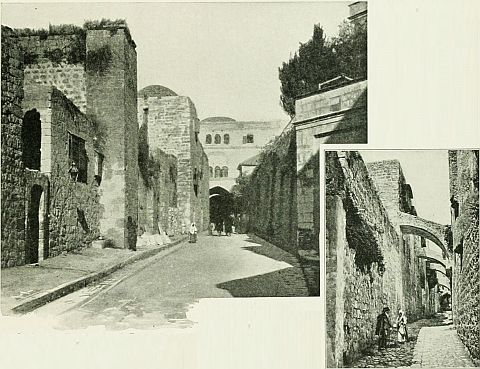 THE VIA DOLOROSA.
THE VIA DOLOROSA.
| 1. Jerusalem. Mary Magdalene. |
| 2. Jerusalem. Other women. |
| 3. Emmaus. Two disciples. |
| 4. Jerusalem. Peter. |
| 5. Jerusalem. Ten apostles. |
| 6. Jerusalem. Eleven apostles. |
| 7. Sea of Galilee. Seven apostles. |
| 8. Mountain in Galilee. Five hundred disciples. |
| 9. Jerusalem(?). James. |
| 10. Bethany. Apostles. [Ascension.] |